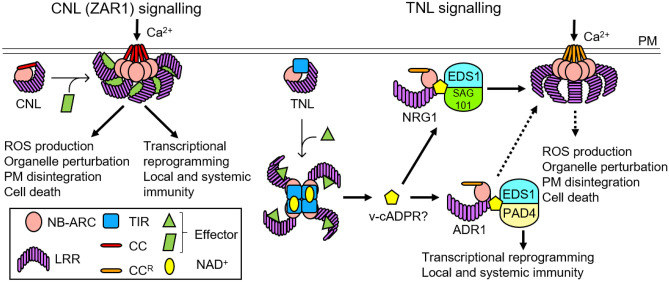Fig. 6.
Working model of NLR-mediated plant innate immune signalling. In a resting state, CNLs and TNLs are in monomeric forms. Upon pathogen recognition, some CNLs, such as ZAR1, form resistosomes that insert into the plasma membrane (PM) and likely act as calcium-permeable channels (Bi et al. 2021). Activated TNLs form resistosomes that act as NAD+-cleaving enzymes (Ma et al. 2020; Martin et al. 2020). NAD+ hydrolysis results in production of plant-specific product, v-cADPR (Wan et al. 2019), which is proposed to signal through downstream components, the EDS1 family and RNLs. TNL activation induces formation of two distinct modules of EDS1:RNL complexes: (1) EDS1:SAG101:NRG1 and (2) EDS1:PAD4:ADR1 (Sun et al. 2021; Wu et al. 2021). Activated RNLs can oligomerize at the plasma membrane and form calcium-permeable channels (Jacob et al. 2021). Calcium influx triggered by the CNL and RNLs is suggested to induce oxidative burst, perturbation of organelles, disintegration of the cell membrane and eventual cell death (Bi et al. 2021). In addition, the EDS1:PAD4:ADR1 module activates transcriptional reprogramming, leading to basal innate immune responses

